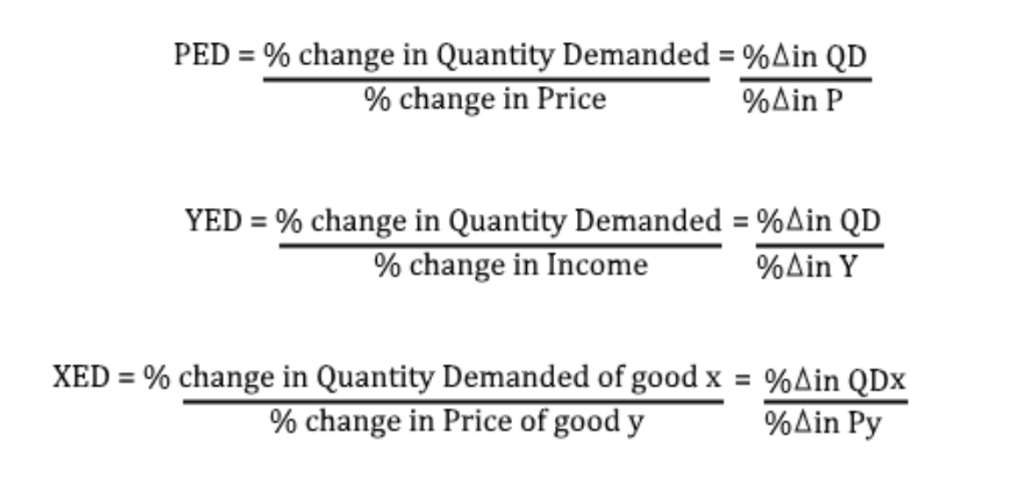Define the term “Elasticity of demand.” Discuss different types of elasticity of demand. Also, explain why this concept should be of interest to anyone in business who has a choice to determine the price at which to sell their products.
The Elasticity of Demand: Understanding Price Sensitivity in Business
Introduction: Elasticity of demand is a fundamental concept in economics that measures the responsiveness of quantity demanded to changes in price. It provides valuable insights into how consumers react to variations in product prices and is a critical tool for businesses in setting optimal pricing strategies. In this discussion, we will define the elasticity of demand, explore its various types, and analyze why this concept is of paramount interest to individuals in business who possess the autonomy to set product prices.
I. Definition of Elasticity of Demand:
The elasticity of demand is a measure that quantifies the percentage change in quantity demanded in response to a percentage change in price. Mathematically, it is expressed as:

The result can be classified into different categories to characterize the nature of the relationship between price and quantity demanded.
II. Types of Elasticity of Demand:
Price Elasticity of Demand (PED):

Interpretation:
- PED > 1 (Elastic): Quantity demanded is responsive to price changes.
- PED = 1 (Unitary Elastic): Percentage change in quantity demanded equals the percentage change in price.
- PED < 1 (Inelastic): Quantity demanded is less responsive to price changes.
Income Elasticity of Demand (YED):
Interpretation:
- YED > 0 (Normal Good): Quantity demanded increases with an increase in income.
- YED < 0 (Inferior Good): Quantity demanded decreases with an increase in income.
Cross Elasticity of Demand (XED):

Interpretation:
- XED > 0 (Substitutes): Goods are substitutes; an increase in the price of one leads to an increase in the quantity demanded for the other.
- XED < 0 (Complements): Goods are complements; an increase in the price of one leads to a decrease in the quantity demanded for the other.
Advertising Elasticity of Demand:

- Interpretation:
- Positive value indicates that advertising has a positive impact on quantity demanded.
III. Importance of Elasticity of Demand in Business:
- Pricing Strategy Formulation:
- Optimal Pricing: Understanding price elasticity allows businesses to set optimal prices. For elastic goods, reducing prices can lead to increased revenue, while for inelastic goods, price increases may result in higher profits.
- Revenue Maximization:
- Total Revenue Test: Businesses can use the total revenue test to determine the optimal price point. If demand is elastic, reducing prices will increase total revenue, and if demand is inelastic, raising prices may achieve the same.
- Market Segmentation:
- Price Discrimination: Knowledge of elasticity enables businesses to engage in price discrimination by offering different prices to different segments. For example, charging a higher price to inelastic demand segments.
- Product Development and Marketing:
- Understanding Consumer Preferences: Elasticity insights can guide product development and marketing strategies. Inelastic goods may benefit from focused marketing efforts, while elastic goods may require differentiation.
- Inventory Management:
- Avoiding Overstock or Stockouts: By understanding demand elasticity, businesses can better manage their inventory. For elastic goods, fluctuations in demand can be more significant, requiring flexible inventory management.
- Government Policies and Taxation:
- Tax Incidence: Elasticity of demand helps in assessing the incidence of taxes. For inelastic goods, the burden of a tax may fall more on consumers, while for elastic goods, producers may bear a larger share.
IV. Real-World Examples:
- Luxury Goods vs. Necessities:
- Luxury Goods (Elastic): Price increases may significantly decrease quantity demanded as consumers have alternatives.
- Necessities (Inelastic): Essential goods often have inelastic demand, as consumers continue to purchase despite price changes.
- Technology Products:
- Highly Elastic: Many technology products, especially in the early stages, have elastic demand. Lowering prices can attract more consumers, leading to increased revenue.
- Pharmaceuticals:
- Inelastic: Certain life-saving medications may have inelastic demand. Consumers are less price-sensitive when it comes to critical health-related products.
V. Challenges in Applying Elasticity:
- Assumption of Ceteris Paribus:
- Other Factors: Elasticity calculations assume that all other factors affecting demand remain constant. In reality, various factors may change simultaneously.
- Limited Data Availability:
- Data Constraints: Obtaining accurate data for elasticity calculations can be challenging, especially for new products or in dynamic markets.
- Complexity in Calculations:
- Mathematical Challenges: Calculating elasticity requires advanced mathematical techniques, making it complex for businesses without analytical resources.
VI. Conclusion:
In conclusion, the elasticity of demand is a pivotal concept for individuals in business who have the autonomy to set prices. Understanding the responsiveness of quantity demanded to price changes allows businesses to formulate effective pricing strategies, maximize revenue, and make informed decisions about product development, marketing, and inventory management. Real-world examples highlight the diverse applications of elasticity across different industries, emphasizing its relevance in dynamic market scenarios.
While challenges exist in the application of elasticity, its importance in guiding businesses toward optimal decision-making cannot be overstated. Businesses that grasp the nuances of elasticity gain a competitive edge, adapt to changing market conditions, and align their strategies with consumer behavior, ultimately contributing to sustained success in the marketplace.
BBA | BMS | MBA | MMS | MCOM| BCOM| Digital Marketing | Soft Skills & Business Communication | Excecutive Coaching | Admission & Coaching Classes | Regular & Distance Online & Offline Tuitions at Kolkata | Assignments Services | Projects & Synopsis | Internship Assistance
9748882085 | 7980975679 | 9331998872
Providing Specialized one-on-one tutoring Services to Executives and students since 2010
